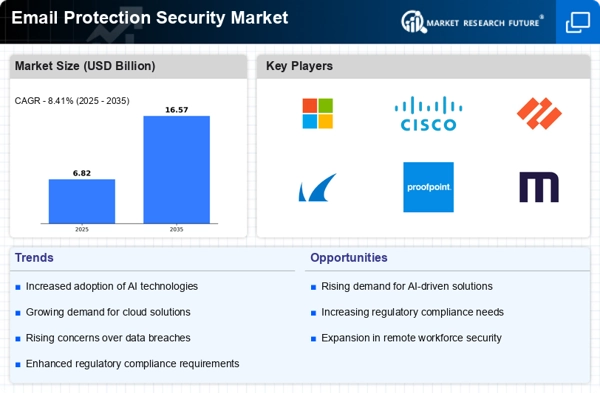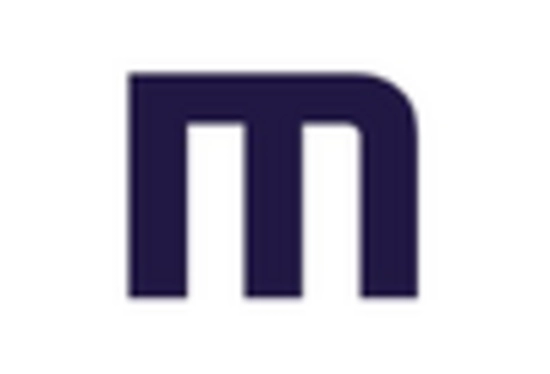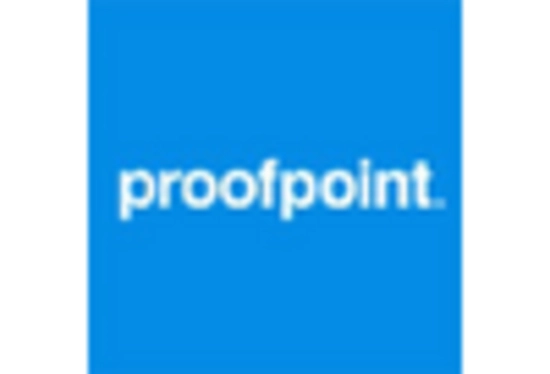Rising Cyber Threats
The Email Protection Security Market is experiencing heightened demand due to the increasing frequency and sophistication of cyber threats. Organizations are facing a surge in phishing attacks, ransomware, and other malicious activities targeting email systems. According to recent data, nearly 90% of cyberattacks begin with an email, underscoring the critical need for robust email security solutions. As businesses recognize the potential financial and reputational damage from data breaches, investments in email protection technologies are likely to escalate. This trend indicates a growing awareness among enterprises about the importance of safeguarding their communication channels, thereby driving the Email Protection Security Market forward.
Increased Regulatory Requirements
The Email Protection Security Market is significantly influenced by the tightening of regulatory requirements surrounding data protection and privacy. Regulations such as the General Data Protection Regulation (GDPR) and the California Consumer Privacy Act (CCPA) mandate stringent measures for safeguarding sensitive information, including email communications. Non-compliance can result in hefty fines and legal repercussions, prompting organizations to invest in comprehensive email security solutions. This regulatory landscape is likely to drive demand for advanced email protection technologies, as businesses seek to ensure compliance while protecting their customers' data. Consequently, the Email Protection Security Market is expected to expand as organizations prioritize regulatory adherence.
Shift Towards Cloud-Based Solutions
The Email Protection Security Market is experiencing a notable shift towards cloud-based email security solutions. As organizations increasingly migrate their operations to the cloud, the demand for scalable and flexible email protection services is on the rise. Cloud-based solutions offer several advantages, including ease of deployment, cost-effectiveness, and the ability to provide continuous updates against emerging threats. This trend is particularly appealing to small and medium-sized enterprises that may lack the resources for on-premises solutions. As more businesses recognize the benefits of cloud technology, the Email Protection Security Market is likely to see accelerated growth, reflecting a broader movement towards cloud adoption in cybersecurity.
Integration of Advanced Technologies
The Email Protection Security Market is witnessing a transformative shift with the integration of advanced technologies such as artificial intelligence and machine learning. These technologies enhance the ability to detect and respond to threats in real-time, significantly improving the efficacy of email security solutions. For instance, AI-driven systems can analyze vast amounts of data to identify patterns indicative of phishing attempts or malware distribution. This capability not only streamlines threat detection but also reduces response times, which is crucial in mitigating potential damages. As organizations increasingly adopt these technologies, the Email Protection Security Market is poised for substantial growth, reflecting a broader trend towards automation in cybersecurity.
Growing Awareness of Cybersecurity Risks
The Email Protection Security Market is benefiting from a growing awareness of cybersecurity risks among organizations of all sizes. As high-profile data breaches and cyber incidents make headlines, businesses are increasingly prioritizing cybersecurity measures, particularly in email communications. This heightened awareness is driving organizations to seek comprehensive email protection solutions that can safeguard against various threats. Furthermore, educational initiatives and training programs aimed at employees are becoming more prevalent, emphasizing the importance of recognizing phishing attempts and other malicious activities. This cultural shift towards prioritizing cybersecurity is likely to bolster the Email Protection Security Market, as organizations invest in solutions that enhance their overall security posture.


















Leave a Comment